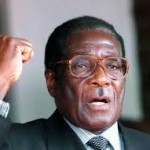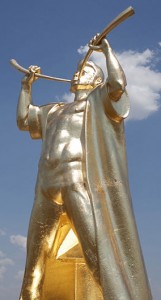
This is what scares me about serving on a jury. This is why I’d never want to be a police detective, or a prosecutor, or work in any field where lives and reputations depend on quick and sure recognition of liars. I tell myself I’m a great judge of character and that I know the truth when I hear it—but the truth is, there are liars whose skill at evasion greatly overpower my skill at detection. And this means that with some cases, some real-life examples of horror and depravity, I’m unlikely to ever know the truth.
In the case of Woody Allen and his adopted daughter Dylan, someone is lying. I just don’t know who it is.
In August 1992, when Dylan was 7 years old, her parents Woody Allen and Mia Farrow were going through an ugly, acrimonious break-up. In the midst of that, Allen visited Farrow and her many children (some of them, not all, were also Allen’s) at the family’s country home in Bridgewater, Connecticut. This was just a few months after the public revelation that Allen, then 55, was leaving Farrow for her 22-year-old daughter Soon-Yi (who’d been adopted by Farrow and her then-husband, composer André Previn).
Those facts are not in dispute. What happened next very much is.
Either something unspeakable happened in that house, specifically in the attic—or, if you’d believe Allen’s version, nothing untoward happened at all. Either Allen utterly betrayed the very ideal of fatherhood, or Mia Farrow molded and used her daughter as a pawn in a family’s disintegration.
As repugnant as it is (no matter which version is true), it’s not at all an unusual scenario. It’s being played out right now, in courtrooms and behind closed family doors, all around the world. The difference here is that from 1992 right up to the present day, this one is being played and replayed in tabloids, talk-shows and online, in front of us all.
In late January, Robert Weide, who’d directed a PBS documentary on Woody Allen, authored a Daily Beast piece on this story, coming down definitively on Allen’s side. In particular, he cited both inconsistencies in Mia Farrow’s statements and actions, and court records which found the allegations “inconclusive;” to suggest that Woody Allen had been unfairly accused. In much the same vein, Allen himself has just published an op-ed in the New York Times, which he says will be his “final word on the matter.” Like Weide, he paints Farrow as a manipulative liar; like Weide, he cites as convincing the fact that he, Allen, took and passed a lie-detector test, while Farrow refused to submit to one.
On the somewhat more objective side, Vanity Fair writer Maureen Orth gives us 10 Undeniable Facts About the Woody Allen Sexual-Abuse Allegation. Regarding that lie-detector test, she informs us that Allen refused to take one administered by the Connecticut State Police, instead sitting for one performed by his own legal team. She also mentions several disturbing examples of Allen’s behavior, particularly toward young Dylan.
Perhaps most compelling of all, and the spark that has reignited this controversy, was An Open Letter From Dylan Farrow, which appeared in Nicholas Kristof’s New York Times blog on February 1. She was writing, she said, as response to Allen’s Academy Award nomination, and she began with words that can only chill you: What’s your favorite Woody Allen movie? Before you answer, you should know…. She followed that with an account of what she says happened in that attic, and other examples that, if true, make Woody Allen nothing less than a monster.
In the end, none of this is evidence. All of it is allegation and counter-accusation. All of it, once again, makes me thankful that no one is relying on me to discern the truth. All of it tempts me mightily to shrug and say— “What difference does it make? It’s a family affair, it’s not my family, and I have no way of knowing what really happened.”
Except…that’s too easy. And too much is at stake. Either an actress whose work I’ve enjoyed has falsely accused a man. Or a director whose work I’ve (somewhat less) enjoyed is and should be beneath my contempt.
Which leads me to the question of what I would do if I could know the truth. Would I feel compelled to eschew the work of someone I knew to be guilty? Could I separate the art from the artist? In 2009, McKenzie Phillips published High On Arrival, in which she made horrible, explosive allegations against her deceased father, musician John Phillips. I read the book, I believe her, and I’m now convinced that John Phillips was the worst kind of scum. Yet I still enjoy his music. What does that say about me?
It’s an uncomfortable question, but I’m not sure it’s a very relevant one as long as I’m stuck in this limbo of not knowing the truth. But in regard to that, I’ll finish with one last personal anecdote:
In 1997, a police captain in my Northeast Ohio hometown was arrested for the murder of his wife. The evidence against him seemed overwhelming, and the general opinion of most people I spoke with was that he was guilty. I guess I felt the same way.
The verdict and sentencing was carried live on local radio, and I was listening. I remember very clearly the statement he delivered before being given a life sentence. He said, “You’ve convicted an innocent man.” He was very convincing, at least to me, and I recall that this was the first time I realized I couldn’t rely on my own ability to discern liars from truth-tellers.
About a year ago, his conviction was overturned based on DNA evidence, and he went free after 15 years in prison. I think, but I cannot be sure, that this validates the uncanny feeling I had that when I heard, “You’ve convicted an innocent man,” I was hearing the truth.
Throughout the Allen/Farrow trial-in-public I’ve been reading conflicting accounts, and with almost all of them I’ve had that I can’t know the truth feeling of detached helplessness. Almost all of them. It was only when I read Dylan Farrow’s open letter that something inside me told me I was reading the truth.
Here’s how she ended it: Imagine your seven-year-old daughter being led into an attic by Woody Allen. Imagine she spends a lifetime stricken with nausea at the mention of his name. Imagine a world that celebrates her tormenter. Are you imagining that? Now, what’s your favorite Woody Allen movie?
I think she’s telling the truth. I think Woody Allen sexually abused her. I think that makes him a criminal, a degenerate, an outcast, and an outlaw. I think he should never again be celebrated as a filmmaker, but instead should be pilloried as a predator.
But—and here’s the crux of the matter—I can’t be sure. I could be wrong. I can only hope for some eventual resolution of this thing, whereby the liars are exposed, the guilty are punished, and the victims, somehow, find comfort. And I can only be thankful, once again, that no one is depending on me to make that happen.
 Duncan Phillips pioneered the collection of American art. He did so at a time when most of the world was loathe to admit Americans could create or even appreciate art. From the 1920s until his death in 1966, he built not only one of the most celebrated publicly displayed collections, but also the foundation of a modern American art movement. He gave American artists, collectors, and critics a basis for self-assertion—and ultimately, self-determination.
Duncan Phillips pioneered the collection of American art. He did so at a time when most of the world was loathe to admit Americans could create or even appreciate art. From the 1920s until his death in 1966, he built not only one of the most celebrated publicly displayed collections, but also the foundation of a modern American art movement. He gave American artists, collectors, and critics a basis for self-assertion—and ultimately, self-determination. It’s not an exaggeration to say that American art wouldn’t be thriving as it is had Duncan Phillips never been born.
It’s not an exaggeration to say that American art wouldn’t be thriving as it is had Duncan Phillips never been born. or relationships or the way we think and talk about sexuality. He just took a leap of faith and
or relationships or the way we think and talk about sexuality. He just took a leap of faith and 

 mindset that aren’t frightened or put off by differences. They seemed to adapt seamlessly to a new, inclusive military. Maybe the same will happen in the NFL.
mindset that aren’t frightened or put off by differences. They seemed to adapt seamlessly to a new, inclusive military. Maybe the same will happen in the NFL. There aren’t many left from the golden era (i.e., Depression-era) of Hollywood. And there aren’t many left from that first generation of child actors. In both categories, perhaps in every category, Little Miss Miracle stood alone.
There aren’t many left from the golden era (i.e., Depression-era) of Hollywood. And there aren’t many left from that first generation of child actors. In both categories, perhaps in every category, Little Miss Miracle stood alone. service. She served as U.S. Ambassador to Ghana and Czechoslovakia, was part of the American delegation to the U.N., and was the first woman to hold the office of Chief of Protocol.
service. She served as U.S. Ambassador to Ghana and Czechoslovakia, was part of the American delegation to the U.N., and was the first woman to hold the office of Chief of Protocol. public eye, in adoration, in a very successful bid to ease minds and hearts in very uncertain times. She deserves a lot of thanks for that too.
public eye, in adoration, in a very successful bid to ease minds and hearts in very uncertain times. She deserves a lot of thanks for that too.
 know that it gets a lot of love back here stateside.
know that it gets a lot of love back here stateside. “Appropriate” might not apply to all art—probably not much public art.. and certainly not commissioned
“Appropriate” might not apply to all art—probably not much public art.. and certainly not commissioned  Robbin Island, who became president of South Africa.
Robbin Island, who became president of South Africa.

 On a cold January day, or any old day, you can reach out and find
On a cold January day, or any old day, you can reach out and find 









 Artist/provocateur
Artist/provocateur  the formerly prosperous and beautiful nation of Zimbabwe into a third-world hellhole. The man has a Hitler mustache, for pete’s sake.
the formerly prosperous and beautiful nation of Zimbabwe into a third-world hellhole. The man has a Hitler mustache, for pete’s sake. October…but not before he constructed a gaudy gold statue of himself (because why not?), and recorded a far-from-complimentary song about Mugabe and his iron-fisted rule. Then last week, he packed up his bag of tricks and went to Zimbabwe.
October…but not before he constructed a gaudy gold statue of himself (because why not?), and recorded a far-from-complimentary song about Mugabe and his iron-fisted rule. Then last week, he packed up his bag of tricks and went to Zimbabwe. Dennis Rodman is looking to justify his ongoing, train-wreck-like
Dennis Rodman is looking to justify his ongoing, train-wreck-like  We’re not only losing the stars of early rock and roll, that dwindling cadre of 1950s musical pioneers… we’re also losing, day by day, most of its fans. It’s been barely an average human lifetime since guitars were electrified, voices harmonized, blues and country and swing unified—into a new sonic style unlike anything heard before. But music has evolved enough, and rock and roll has moved on enough, that too many of us are forgetting, ignoring, its truly still-fresh roots. The first generation of listeners are dwindling too, as are the numbers of “golden oldie” radio and satellite stations. Tastes have irrevocably changed. There’s little room these days, on our playlists and, if we’re being honest, in our consciousness, for the doo-wop vocals and imprecise strumming that defined the fifties.
We’re not only losing the stars of early rock and roll, that dwindling cadre of 1950s musical pioneers… we’re also losing, day by day, most of its fans. It’s been barely an average human lifetime since guitars were electrified, voices harmonized, blues and country and swing unified—into a new sonic style unlike anything heard before. But music has evolved enough, and rock and roll has moved on enough, that too many of us are forgetting, ignoring, its truly still-fresh roots. The first generation of listeners are dwindling too, as are the numbers of “golden oldie” radio and satellite stations. Tastes have irrevocably changed. There’s little room these days, on our playlists and, if we’re being honest, in our consciousness, for the doo-wop vocals and imprecise strumming that defined the fifties. Happy New Year. Right about now, if you’re anything like me, you’re pondering the efficacy and desirability of new years’ resolutions. And if you’re anything like me, and you’ve dabbled in such things in the past, you’ve got a spotty history of success.
Happy New Year. Right about now, if you’re anything like me, you’re pondering the efficacy and desirability of new years’ resolutions. And if you’re anything like me, and you’ve dabbled in such things in the past, you’ve got a spotty history of success. “Carbs,” he said. “Show me someone with a weight problem and I’ll show you someone who has a problem with carbs.”
“Carbs,” he said. “Show me someone with a weight problem and I’ll show you someone who has a problem with carbs.”
 A lot of jaws have been grinding trying to gnash out some deeper meaning in this sorry episode. Free-speech was an early contentious contender, until the Internet pointed out with pissy yet irrefutable logic that free speech never entered into the thing. Except perhaps in an exemplary way: Phil freely exercised his rights, just as the howlers on both sides, and the network, exercised theirs.
A lot of jaws have been grinding trying to gnash out some deeper meaning in this sorry episode. Free-speech was an early contentious contender, until the Internet pointed out with pissy yet irrefutable logic that free speech never entered into the thing. Except perhaps in an exemplary way: Phil freely exercised his rights, just as the howlers on both sides, and the network, exercised theirs.
 The other honorees are: playwright and novelist
The other honorees are: playwright and novelist 
 Joan Fontaine (Oct. 22 1917 – Dec. 15 2013) Oscar-winning Best Actress, who in fact was the only winner of the Best Actor or Best Actress award for any of Hitchcock’s films. She was glamor personified, and an extraordinary practitioner of her craft. She died peacefully in her sleep at home in Carmel, California on Sunday.
Joan Fontaine (Oct. 22 1917 – Dec. 15 2013) Oscar-winning Best Actress, who in fact was the only winner of the Best Actor or Best Actress award for any of Hitchcock’s films. She was glamor personified, and an extraordinary practitioner of her craft. She died peacefully in her sleep at home in Carmel, California on Sunday. Tom Laughlin (Aug. 10 1931 – Dec. 12, 2013) Never has an actor been so thoroughly identified with a single role, without suffering the career debilitation of typecasting. Tom Laughlin was Billy Jack; he created that character, not just as an actor but also as screenwriter and director. In four films, from 1967 to 1977, Billy Jack delivered a message of self-determination that is just as relevant today as it was 40 years ago. Tom Laughlin died Thursday in Thousand Oaks, California, of complications from pneumonia.
Tom Laughlin (Aug. 10 1931 – Dec. 12, 2013) Never has an actor been so thoroughly identified with a single role, without suffering the career debilitation of typecasting. Tom Laughlin was Billy Jack; he created that character, not just as an actor but also as screenwriter and director. In four films, from 1967 to 1977, Billy Jack delivered a message of self-determination that is just as relevant today as it was 40 years ago. Tom Laughlin died Thursday in Thousand Oaks, California, of complications from pneumonia. Peter O’Toole (Aug. 2 1932 – Dec. 14 2013) Probably a child of Ireland, although O’Toole himself wasn’t sure where he was born (likely bets: County Galway, Ireland, or Leeds, Yorkshire). Not exactly physically imposing, he nonetheless personified Hollywood’s leading man. From his career-making role as Lawrence of Arabia, to his two incredible turns as Henry II (The Lion in Winter, and Becket), he inhabited every character he played. He continued doing so well into his twilight years. He died Saturday in London, after a long illness.
Peter O’Toole (Aug. 2 1932 – Dec. 14 2013) Probably a child of Ireland, although O’Toole himself wasn’t sure where he was born (likely bets: County Galway, Ireland, or Leeds, Yorkshire). Not exactly physically imposing, he nonetheless personified Hollywood’s leading man. From his career-making role as Lawrence of Arabia, to his two incredible turns as Henry II (The Lion in Winter, and Becket), he inhabited every character he played. He continued doing so well into his twilight years. He died Saturday in London, after a long illness. Ray Price (Jan. 12 1926 – Dec. 16 2013) Not one of the best known country music artists, but certainly one of the most influential. As understudy and confidante to Hank Williams, he helped create the honky-tonk genre of the fifties. A couple of decades later, he brought orchestral arrangement to C&W, birthing the Nashville Sound. Along the way he worked with, and was honored by, artists ranging from Willie Nelson, Waylon Jennings, and Kris Kristofferson. He died Monday at home in Mount Pleasant, Texas of pancreatic cancer.
Ray Price (Jan. 12 1926 – Dec. 16 2013) Not one of the best known country music artists, but certainly one of the most influential. As understudy and confidante to Hank Williams, he helped create the honky-tonk genre of the fifties. A couple of decades later, he brought orchestral arrangement to C&W, birthing the Nashville Sound. Along the way he worked with, and was honored by, artists ranging from Willie Nelson, Waylon Jennings, and Kris Kristofferson. He died Monday at home in Mount Pleasant, Texas of pancreatic cancer.